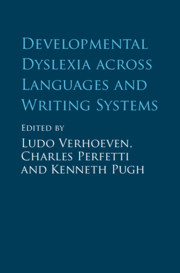Book contents
- Developmental Dyslexia across Languages and Writing Systems
- Developmental Dyslexia across Languages and Writing Systems
- Copyright page
- Contents
- Figures
- Tables
- Contributors
- 1 Introduction
- Part I Developmental Dyslexia across Languages and Writing Systems
- 2 Developmental Dyslexia in English
- 3 Developmental Dyslexia in French
- 4 Developmental Dyslexia in Dutch
- 5 Developmental Dyslexia in Czech and Slovak
- 6 Developmental Dyslexia in Finnish
- 7 Developmental Dyslexia in Russian
- 8 Developmental Dyslexia in Hebrew
- 9 Developmental Dyslexia in Japanese
- 10 Developmental Dyslexia in Chinese
- Part II Cross-Linguistic Perspectives on Developmental Dyslexia
- Epilogue
- Index
- References
3 - Developmental Dyslexia in French
from Part I - Developmental Dyslexia across Languages and Writing Systems
Published online by Cambridge University Press: 27 September 2019
- Developmental Dyslexia across Languages and Writing Systems
- Developmental Dyslexia across Languages and Writing Systems
- Copyright page
- Contents
- Figures
- Tables
- Contributors
- 1 Introduction
- Part I Developmental Dyslexia across Languages and Writing Systems
- 2 Developmental Dyslexia in English
- 3 Developmental Dyslexia in French
- 4 Developmental Dyslexia in Dutch
- 5 Developmental Dyslexia in Czech and Slovak
- 6 Developmental Dyslexia in Finnish
- 7 Developmental Dyslexia in Russian
- 8 Developmental Dyslexia in Hebrew
- 9 Developmental Dyslexia in Japanese
- 10 Developmental Dyslexia in Chinese
- Part II Cross-Linguistic Perspectives on Developmental Dyslexia
- Epilogue
- Index
- References
Summary
Reading comprehension requires the ability to both accurately and fluently identify written words and to understand spoken language (Perfetti, 1985, 2007). The main task facing beginning readers, then, is to find a means of understanding written texts as skillfully as they process spoken language. To this end, and to be able to allocate a large part of their processing capacity to reading comprehension, children must develop precise and rapid access to written words. Dyslexics’ reading problems, by definition, are about identifying written words (Lyon, Shaywitz, & Shaywitz, 2003). To understand the problems facing dyslexic readers, it is necessary to determine what is involved in reading in their writing system; which, for French-speaking children, is an alphabetic system.
- Type
- Chapter
- Information
- Publisher: Cambridge University PressPrint publication year: 2019
References
- 6
- Cited by

